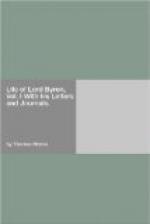“Adieu. Yours faithfully,” &c.
LETTER 38.
TO MR. HODGSON.
“Gibraltar, August 6. 1809.
“I have just arrived at this place after a journey through Portugal, and a part of Spain, of nearly 500 miles. We left Lisbon and travelled on horseback[119] to Seville and Cadiz, and thence in the Hyperion frigate to Gibraltar. The horses are excellent—we rode seventy miles a day. Eggs and wine, and hard beds, are all the accommodation we found, and, in such torrid weather, quite enough. My health is better than in England.
“Seville is a fine town, and the Sierra Morena, part of which we crossed, a very sufficient mountain; but damn description, it is always disgusting. Cadiz, sweet Cadiz!—it is the first spot in the creation. The beauty of its streets and mansions is only excelled by the loveliness of its inhabitants. For, with all national prejudice, I must confess the women of Cadiz are as far superior to the English women in beauty as the Spaniards are inferior to the English in every quality that dignifies the name of man. Just as I began to know the principal persons of the city, I was obliged to sail.
“You will not expect a long letter after my riding so far ’on hollow pampered jades of Asia.’ Talking of Asia puts me in mind of Africa, which is within five miles of my present residence. I am going over before I go on to Constantinople.
“Cadiz is a complete Cythera. Many of the grandees who have left Madrid during the troubles reside there, and I do believe it is the prettiest and cleanest town in Europe. London is filthy in the comparison. The Spanish women are all alike, their education the same. The wife of a duke is, in information, as the wife of a peasant,—the wife of a peasant, in manner, equal to a duchess. Certainly they are fascinating; but their minds have only one idea, and the business of their lives is intrigue.
“I have seen Sir John Carr at Seville and Cadiz, and, like Swift’s barber, have been down on my knees to beg he would not put me into black and white. Pray remember me to the Drurys and the Davies, and all of that stamp who are yet extant.[120] Send me a letter and news to Malta. My next epistle shall be from Mount Caucasus or Mount Sion. I shall return to Spain before I see England, for I am enamoured of the country.
Adieu, and believe me,” &c.
In a letter to Mrs. Byron, dated a few days later, from Gibraltar, he recapitulates the same account of his progress, only dwelling rather more diffusely on some of the details. Thus, of Cintra and Mafra:—“To make amends for this,[121] the village of Cintra, about fifteen miles from the capital, is, perhaps in every respect, the most delightful in Europe; it contains beauties of every description, natural and artificial. Palaces and gardens rising in the midst of rocks, cataracts, and precipices; convents on stupendous heights—a




